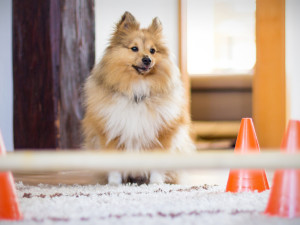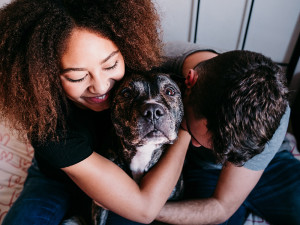How to Spark Joy in Your Dog’s Life
(And your own, while you’re at it.)

Share Article
You do a lot for your dog: you walk themopens in a new tab, feed themopens in a new tab, groom themopens in a new tab, take them to the vetopens in a new tab, spoil them with squeaky toys, buy them adorable sweaters (okay, that last one’s all you)... In other words, you’re probably ticking all the dog-duty boxes, and that’s great. But here’s the thing: Meeting your dog’s basic needs isn’t the only way to keep them happy and healthy. There are a lot of little things you can do that (thankfully) don’t require a ton of extra work. Try these tips to boost your dog’s joy — and your own in the process.
1. Make Life An Adventure
Many dogs sniffing out new places, so instead of taking the same walk every day, explore new territoryopens in a new tab: A swimming hole, a hiking trailopens in a new tab, or even just walking in a new neighborhood can add fun and interest to your dog’s life. Any unfamiliar place will be full of new smells, and that’s a pleasure for many dogs. (You get bonus points if your dog loves car ridesopens in a new tab since new adventures often involve taking a drive.)

Get (totally free) deals for food, treats, accessories, tech, and way more pet parenting must-haves.
opens in a new tab2. Let Your Dog Make Choices
Most dogs love the freedom to make their own decisions. If there are places your dog can safely be off-leash, take advantage of them. Allow your dog to choose where to run and how fast, whether to roll or frolic, and what to smell and for how long.
When that’s not possible, give your dog choices on some of your walks. Let them choose the route, the pace and what is worthy of extensive sniffingopens in a new tab. Just like us, dogs like the chance to do what they want to do — to explore and to roam — and facilitating that is a great kindness.
3. Play, Play and Play Some More
I cannot emphasize enough how much play can add to a dog’s happiness. If dogs could talk, many of them would probably say that play time is the best part of the day. When dogs play, they are having fun, which is often the most direct route to happiness. In addition to the obvious fun, play also provides mental and physical exercise and socializing opportunities, and leads to feelings of success as well as enhanced cooperation. Plus, it’s a great boredom-buster.
If your dog loves to play in certain ways, indulge them in that kind of fun; if your dog doesn't have specific interests, explore things that may intrigue them. Many dogs learn to love play if you teach them to be interested in toys. Of course, not all dogs take to toys, but many will learn to love them with a little help. If you think your dog has no interest in play, I urge you to explore chase games before you close the book on the subject. Many people find that if they teach their dogs how to play and entice them with just the right kind of games, dogs who seemed uninterested turn out to be playful after all.
4. Make Toys and Chews a Priority
Enriching objects and activities prevent dog boredom while providing mental exercise. Chewing is a very natural activity for dogs. I know from my own household accounting just how expensive it can be to supply new chewables, but still, I encourage you to budget for them. Remember that dogs are using those toys, not ruining them. If your dog tends to pull the stuffing out of fleece toys, consider buying them toys without stuffing.
Since chew items are meant to be used up, it’s worth paying attention to how much bang for your buck you get with the various options, and choose more durable items if they appeal to your dog. Real bones, yak milk chews, and bully sticks are all good options. Of course, you’ll want to monitor your dog’s chewing to be sure they’re not swallowing the pieces or otherwise harming themself. Always check with your veterinarian about what is safe for your particular dog, and what is good, rather than harmful, for their teeth.
5. Learn More About Your Dog
The more you understand dogs, the easier it is to avoid misreading them and to successfully communicate with them. Brush up on dog body languageopens in a new tab or learn more about cognition, training, and behavior. Adding to your dog knowledge will help you to clear up any confusion between the two of you or to figure out what they want. It’s especially helpful to be able to recognize signs that your dog is stressed, nervousopens in a new tab, scared, or uncomfortable so you can alleviate the situation by changing the context, or removing them from it.
6. Vary Your Dog’s Food
There’s plenty of debate about what constitutes the healthiest diet for dogsopens in a new tab. However, few disagree on the value of varying a dog’s food. If your dog can tolerate change in their diet, mixing things up a bit and adding fresh foodopens in a new tab will bring them serious joy. This applies to treats opens in a new tabas well; when I’m training, I often change up the treats. (Note: You know your dog; if GI issues require them to eat the same thing on a regular basis, this suggestion doesn’t apply.)
7. Protect Your Pup From What They Dislike
Some dogs love having a horde of children around them, but other dogs are miserable in that situation. Whether your dog objects to the ceiling fan, the sound of the kettle boiling, the doorbell or the cat eating their food, there are usually ways to avoid minor domestic irritations.
If your dog objects to being barked at through the fence by a neighbor’s dog while on a walk, take another route. If your dog hates having their matted fur combed out; make time each day to brush them so the mats don’t form in the first place. Many dogs are irritated by the constant jingling of their tags; tape the tags together or stow them in a tag-silencing pouch. Every dog is different, but if you figure out that something bothers your dog, find a way to shield them from it.
8. Keep On Training
You’re never done trainingopens in a new tab a dog. (Sorry, puppy classesopens in a new tab aren’t enough.) Training involves so much more than teaching basic manners and skills, and it’s a process that can yield ongoing benefits. Dogs who are well trained can be given more freedom, have more opportunities to socialize and are able to go more places. They are less likely to become frustrated and confused if they know what you want them to do.
Other rewards include relationship-building, increased self-esteem for your dog, and more pleasant visits to the vet — a well-trained dog can be examined and treated with less stress because they know how to respond to requests and require less (if any) physical manipulation.
9. Rub Them The Right Way
I’m always charmed by dogs’ contented sighs when they’re being rubbed in exactly the right spotopens in a new tab. Many dogs love to have their hips, neck, chest, and the area just above their tail gently massaged. Read about opens in a new tabor watch a how-to video on canine massage or touch techniquesopens in a new tab and put your new skills to use — your dog will thank you for it.
10. Accept Them For Who They Are
There’s great happiness in being loved as you are rather than being pressured to be what you’re not (that’s as true for dogs as it is for people). So, if your dog loves to snuggle, let them; if your dog prefers their own space, don’t force them into cuddle time that only you enjoy. If your dog loves tug but is quickly bored by retrieving, accept that you have a dog who’s not interested in endless games of fetch. If your dog thinks they’re part cat when they’re near water and wants no part of that wetness, let go of your plans to spend Saturdays in the lake together. Your dog is who they are, and there’s no more profound way to increase their happiness than to let go of attempts to change them, and love them just the way they are.

Karen B. London, PhD, CAAB, CPDT-KA
Karen B. London, Ph.D., is a Certified Applied Animal Behaviorist and Certified Professional Dog Trainer who specializes in working with dogs with serious behavioral issues, including aggression, and has also trained other animals including cats, birds, snakes, and insects. She writes the animal column for the Arizona Daily Sun and is an Adjunct Professor in the Department of Biological Sciences at Northern Arizona University. She is the author of six books about training and behavior, including her most recent, Treat Everyone Like a Dog: How a Dog Trainer’s World View Can Improve Your Lifeopens in a new tab.

